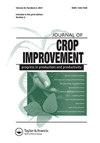Floral volatiles may influence honey bee visitations in oilseed Brassica species
IF 1
Q3 AGRONOMY
引用次数: 0
Abstract
ABSTRACT Understanding foraging preferences of honey bees (Apis mellifera L.) is essential to maneuver pollinator movement to enhance outcrossing and hence the crop yields. In this communication, we report the role of floral volatile organic compounds (VOCs) in structuring foraging decisions of honey bees. Supercritical fluid extraction of VOCs, coupled with gas chromatography-mass spectrometry, revealed 75 VOCs. Of these, 19 were strong attractants and 8 were strong repellants. Moreover, we detected significant, but variable, species- or genome-level differences in floral scents. Honey bees avoided Brassica juncea cv. PBR357 (0.81 bee visits/sq m/min) and B. carinata cv. PC5 (0.77 bee visits/sq m/min), which possessed peak concentrations of antifeedants or repellents (dibutyl phthalate and 9-octadecenoic acid) in their floral volatiles. B. napus cvs. GSC6 and GSC7 attracted the highest number of bee visitations (1.07 and 0.99 bee visits/sq m/min, respectively), as these possessed VOCs with honey-fruity odor in high amounts and negligible levels of antifeedants. Our results highlight that variability in floral reward chemistry should be considered when breeding crops that are frequently visited upon by bee pollinators to support bee pollinators, in general, and honey industry, in particular.花的挥发物可能影响蜜蜂在油籽芸苔种的访问
摘要了解蜜蜂(Apis mellifera L.)的觅食偏好对于控制传粉昆虫的运动以提高异交从而提高作物产量至关重要。在这篇通讯中,我们报道了花挥发性有机化合物(VOC)在构建蜜蜂觅食决策中的作用。超临界流体萃取挥发性有机物,结合气相色谱-质谱分析,发现75种挥发性有机物。其中,19种是强引诱剂,8种是强排斥剂。此外,我们在花香中检测到了显著但可变的物种或基因组水平差异。蜜蜂避开了芥菜品种PBR357(0.81次蜜蜂访视/平方米/分钟)和卡氏B.carinata品种PC5(0.77次蜜蜂访问/平方米每分钟),它们的花挥发物中具有最高浓度的拒食剂或排斥剂(邻苯二甲酸二丁酯和9-十八碳烯酸)。甘蓝型油菜。GSC6和GSC7吸引了最多的蜜蜂造访(分别为1.07和0.99次蜜蜂造访/平方米/分钟),因为它们具有大量带有蜂蜜水果味的挥发性有机物,拒食水平可以忽略不计。我们的研究结果强调,在培育蜜蜂授粉者经常造访的作物以支持蜜蜂授粉者,特别是蜂蜜行业时,应考虑花朵奖励化学的可变性。
本文章由计算机程序翻译,如有差异,请以英文原文为准。
求助全文
约1分钟内获得全文
求助全文
来源期刊

Journal of Crop Improvement
Multiple-
CiteScore
3.30
自引率
7.70%
发文量
42
期刊介绍:
Journal of Crop Science and Biotechnology (JCSB) is a peer-reviewed international journal published four times a year. JCSB publishes novel and advanced original research articles on topics related to the production science of field crops and resource plants, including cropping systems, sustainable agriculture, environmental change, post-harvest management, biodiversity, crop improvement, and recent advances in physiology and molecular biology. Also covered are related subjects in a wide range of sciences such as the ecological and physiological aspects of crop production and genetic, breeding, and biotechnological approaches for crop improvement.
 求助内容:
求助内容: 应助结果提醒方式:
应助结果提醒方式:


